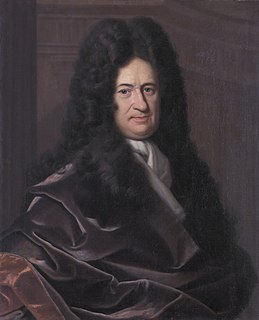
Algebraic geometry is a branch of mathematics, classically studying zeros of multivariate polynomials. Modern algebraic geometry is based on the use of abstract algebraic techniques, mainly from commutative algebra, for solving geometrical problems about these sets of zeros.

The history of calculus is fraught with philosophical debates about the meaning and logical validity of fluxions or infinitesimal numbers. The standard way to resolve these debates is to define the operations of calculus using epsilon–delta procedures rather than infinitesimals. Nonstandard analysis instead reformulates the calculus using a logically rigorous notion of infinitesimal numbers.
In mathematics, a transcendental function is an analytic function that does not satisfy a polynomial equation, in contrast to an algebraic function. In other words, a transcendental function "transcends" algebra in that it cannot be expressed in terms of a finite sequence of the algebraic operations of addition, subtraction, multiplication, division, raising to a power, and root extraction.
Reverse mathematics is a program in mathematical logic that seeks to determine which axioms are required to prove theorems of mathematics. Its defining method can briefly be described as "going backwards from the theorems to the axioms", in contrast to the ordinary mathematical practice of deriving theorems from axioms. It can be conceptualized as sculpting out necessary conditions from sufficient ones.
In logic and mathematics second-order logic is an extension of first-order logic, which itself is an extension of propositional logic. Second-order logic is in turn extended by higher-order logic and type theory.
In the foundations of mathematics, von Neumann–Bernays–Gödel set theory (NBG) is an axiomatic set theory that is a conservative extension of Zermelo–Fraenkel-Choice set theory (ZFC). NBG introduces the notion of class, which is a collection of sets defined by a formula whose quantifiers range only over sets. NBG can define classes that are larger than sets, such as the class of all sets and the class of all ordinals. Morse–Kelley set theory (MK) allows classes to be defined by formulas whose quantifiers range over classes. NBG is finitely axiomatizable, while ZFC and MK are not.
In mathematics, a real closed field is a field F that has the same first-order properties as the field of real numbers. Some examples are the field of real numbers, the field of real algebraic numbers, and the field of hyperreal numbers.
In quantum field theory, the Wightman distributions can be analytically continued to analytic functions in Euclidean space with the domain restricted to the ordered set of points in Euclidean space with no coinciding points. These functions are called the Schwinger functions and they are real-analytic, symmetric under the permutation of arguments, Euclidean covariant and satisfy a property known as reflection positivity. Properties of Schwinger functions are known as Osterwalder-Schrader axioms. Schwinger functions are also referred to as Euclidean correlation functions.

In mathematics, specifically transcendental number theory, Schanuel's conjecture is a conjecture made by Stephen Schanuel in the 1960s concerning the transcendence degree of certain field extensions of the rational numbers.
In mathematics, real algebraic geometry is the sub-branch of algebraic geometry studying real algebraic sets, i.e. real-number solutions to algebraic equations with real-number coefficients, and mappings between them.
In mathematics, exponential polynomials are functions on fields, rings, or abelian groups that take the form of polynomials in a variable and an exponential function.

Angus John Macintyre FRS, FRSE is a British mathematician and logician who is a leading figure in model theory, logic, and their applications in algebra, algebraic geometry, and number theory. He is Emeritus Professor of Mathematics, at Queen Mary University of London.
In mathematics, Pfaffian functions are a certain class of functions whose derivative can be written in terms of the original function. They were originally introduced by Askold Khovanskii in the 1970s, but are named after German mathematician Johann Pfaff.
In model theory, Tarski's exponential function problem asks whether the theory of the real numbers together with the exponential function is decidable. Alfred Tarski had previously shown that the theory of the real numbers is decidable.
In mathematics, the Tarski–Seidenberg theorem states that a set in (n + 1)-dimensional space defined by polynomial equations and inequalities can be projected down onto n-dimensional space, and the resulting set is still definable in terms of polynomial identities and inequalities. The theorem—also known as the Tarski–Seidenberg projection property—is named after Alfred Tarski and Abraham Seidenberg. It implies that quantifier elimination is possible over the reals, that is that every formula constructed from polynomial equations and inequalities by logical connectives ∨ (or), ∧ (and), ¬ (not) and quantifiers ∀, ∃ (exists) is equivalent to a similar formula without quantifiers. An important consequence is the decidability of the theory of real-closed fields.
In mathematics, an exponential field is a field that has an extra operation on its elements which extends the usual idea of exponentiation.

In mathematics, specifically set theory, the Cartesian product of two sets A and B, denoted A × B, is the set of all ordered pairs (a, b) where a is in A and b is in B. In terms of set-builder notation, that is
In mathematical logic, and more specifically in model theory, an infinite structure (M,<,...) which is totally ordered by < is called an o-minimal structure if and only if every definable subset X ⊂ M is a finite union of intervals and points.
In mathematics, an ordered exponential field is an ordered field together with a function which generalises the idea of exponential functions on the ordered field of real numbers.





